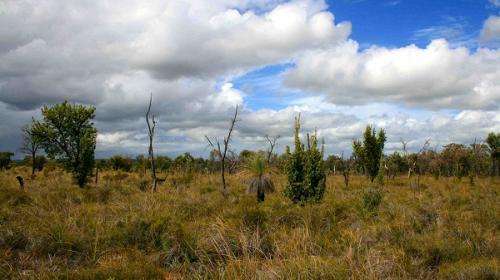Dieback devastates south-west bird communities

In the first study of its kind, researchers have investigated how dieback negatively impacts bird communities in south-western Australia by altering the structure of vegetation and causing the loss of flower species they use as food.
Dr Robert Davis from Edith Cowan University says some national parks in Western Australia are already over 60 per cent infested with dieback and yet we have a poor understanding of its impact on native fauna.
"Phytopthora cinnamomi, the soil-borne water mould commonly known as dieback, is one of the greatest emerging threats to biodiversity in southern Australia," Dr Davis says.
"It has the potential to affect the populations of many already endangered birds of the south-west by wiping out their food sources."
Researchers examined bird communities in Banksia woodlands with, and without, dieback in the biodiversity hotspot of south-western Australia. They surveyed the area every month for seven months.
They found diseased sites had reduced plant species richness, litter, shrub, tree and canopy cover, high bare ground and significantly lower flowering scores than healthy sites.
Bird community composition differed significantly between diseased and healthy sites, although total bird abundance, total species richness and foraging guilds did not.
Dieback converts these areas to heathland-like habitats with no canopy which impacts animal species that rely on tree canopies and the resources that they provide.
Many birds rely on the nectar from Banksias as their primary food source.
"Banksias are highly susceptible to dieback and the loss of this resource can be potentially disastrous for species such as the western spinebill, honey possum and Carnaby's Black-Cockatoo that depend on these flowers," says Dr Davis.
"Such species have to move elsewhere, but in landscapes that are already fragmented from urbanisation or agriculture, this could be a real problem."
All nectarivorous birds that rely on Banskia and other proteaceous species for their survival are potentially at risk.
Dr Davis says dieback is easily spread in moist conditions by bush-walkers, off-road vehicles and animals. The worst affected areas are usually caused by human disturbance.
"The spread of dieback needs to be prevented with strict quarantine measures, including preventing illegal off-road vehicles in reserves, limiting hikers to tracks and providing stations for cleaning vehicles and boots," Dr Davis says.
"The application of phosphite can help the survival of trees that are already infected with dieback and aerial spraying can assist with slowing the spread of this pathogen."
More information: Robert A. Davis, Leonie E. Valentine, Michael D. Craig, Barbara Wilson, Wesley J. Bancroft, Marnie Mallie, "Impact of Phytophthora-dieback on birds in Banksia woodlands in south west Western Australia," Biological Conservation, Volume 171, March 2014, Pages 136-144, ISSN 0006-3207, dx.doi.org/10.1016/j.biocon.2014.01.027.
Journal information: Biological Conservation
Provided by Science Network WA



















